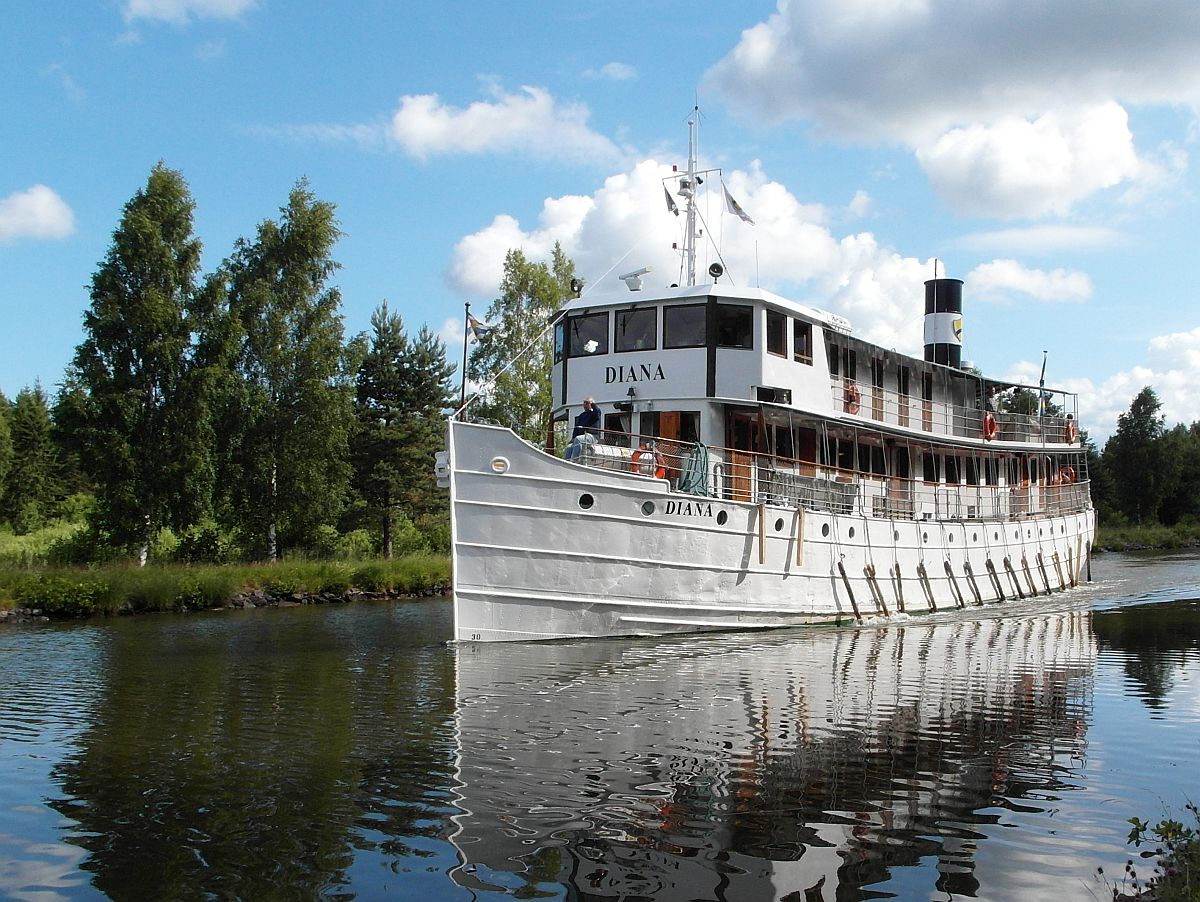
Swedish traders had since the early 16th century dreamed of a shipping route across the Swedish peninsula from Stockholm to Gothenburg, by-passing the Baltic Sea with its passage through the Kattegat straits. By the early 19th century they had built several sections of canal and joined some of their lakes to each other, but they had been defeated by a number of engineering challenges - particularly at the western end of the canal where the steep climb around the 100 ft high Trollhatten Falls had proved insurmountable. The opening of the Caledonian Canal in Scotland had brought international fame to one of Britain's foremost canal engineers, Thomas Telford, and his help was promptly sought by the Swedish canal-builders. With Telford's help the 120-mile long Gota Canal, with its 65 locks, was completed and finally opened in 1832; it shared one enduring characteristic with the Caledonian Canal, that it was opened many years behind schedule and as a result was never commercially successful.
There have been passenger steamers on the canal since 1869 and one of their earliest ones, the Juno, is still in use after almost 140 years of service. The design of the Swedish "Archipelago steamers" - most of which plied trade amongst the islands near Stockholm - remained largely unchanged for many years, and three of them still ply the entire route from Stockolm to Gothenburg while a number of the slightly smaller craft run shorter trips along parts of the canal. The most modern of them is the Diana which, although a replica of the 19th century passenger steamers, dates from 1931 and was refitted in its original style in 2003. This ship takes 6 days to make the journey, which gives more time to see the sights along the route than do the other ships that take only 4 days, so we decided to book ourselves on this trip for 2013.
The approach to Stockholm airport is spectacularly beautiful, and a taxi took us to a beautiful old hotel for our first night. Exploring the Old Town area we discovered a busy thriving harbour filled with craft of all types and sizes, including hundreds of sailing boats that were gathering for the following few days races. There were a number of modern passenger boats offering trips around the harbour, and we decided to take the hour-long "under the bridges" tour which gives a fascinating view of much of Stockholm; it was also very educational with commentaries available in a dozen different languages; we learned for example that the name of the town means "Fortified Island" (that's Stock as in our Stockade).
On this trip we saw all types and sizes of boats, old and new. Click here to see a whole page of interesting craft that we saw both here and on the canal.
Stockholm was clearly a busy vibrant city, and in the fine weather the streets and cafes were all full of people. Looking at the menus on display we realised that food was fairly pricy but drink was unbelievably expensive; so we resolved to eat well and drink moderately. We found a wonderful restaurant in the Old Town, and sat at a pavement table for a magnificent evening meal which included (vegetarians please look away now) lamb, pork, ham, boar, bear, moose, and reindeer !
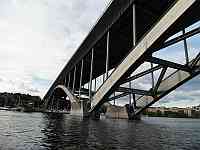 |
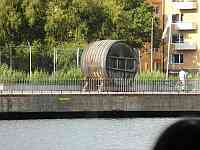 |
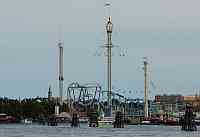 |
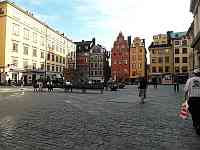 |
Under the bridges of Stockholm |
They don't make Vodka barrels like this any more! |
The magnificent funfair on an island in the harbour |
In the Old Town |
The next morning we were down at the harbour early to join our ship the Diana. The crew rolled out a small red carpet on the quayside before welcoming us on board and showing us to our delightful cabin; we realised that we had made a good choice by having a cabin on the lowest deck. The cabins on the upper deck were much more expensive and yet they were tiny, they had bunk beds, their door opened only to the outside deck (which could be inconvenient on a rainy night as they had no en-suite facilities) and they had no opening windows so that for ventilation at night it was necessary to leave the door ajar. The standard of fixtures and fittings in the cabin, as well as throughout the rest of the ship, was absolutely fantastic in original period style. At the briefing in the elegant dining room the captain explained that the intent was to create a happy atmosphere, as if we were all friends and family on a cruise together, to which end for example there were no locks on any of the cabin doors although any valuables could be stored in the ship's safe if required; similarly there were "honesty bars" so that anybody who wanted a drink could simply help themselves and sign the book.
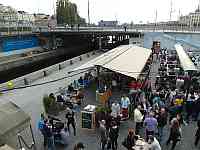 |
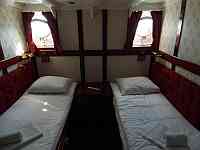 |
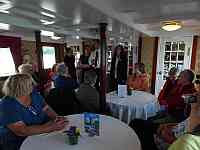 |
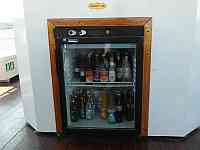 |
This scene next to a lock reminded us of Camden Lock |
Our cabin was beautifully fitted |
Before sailing we had a briefing in the dining room |
The honesty bar on the top deck |
As we left Stockholm harbour through the same lock that we had passed through on the tour the day before, the lock which had reminded me so much of London's Camden Lock, we sat on the bows of the boat wondering about the pile of logs which we found there. The crew explained to us that these were birch branches for use as fenders along the sides of the ship, and that the ship would travel with their ends permanently dangling in the water so that the wood remained soft and supple; this is the opposite of the convention on our canals, where side fenders are made from rope or (more recently) either rubber or plastic and it is traditionally regarded as poor boatmanship not to raise them when travelling.
Soon we were crossing lake Malaren and passing the beautiful Drottningham Castle which has been the Royal Family's residence since 1981. Lake Malaren is the third largest in Sweden, and it is kept just 1ft above sea level for, although there is virtually no tide in this part of the Baltic, even slight changes in sea level would otherwise cause unacceptably rapid currents to flow through its approaches. Under blue skies we crossed the lake and then locked back down to sea level through a huge lock (450 ft long) - having taken a shortcut past several miles of Baltic Sea. The navigation here was crossed by a road with a lift bridge and by a railway at a higher level; bridges were to be a notable feature of the trip; for example a few miles south of the lock we passed under a set of three bridges which could each be opened in a different way; one opened in the middle, one opened from just one end, and one remained horizontal while the whole bridge platform was raised or lowered.
Trosa is a pretty little village, with a small river running parallel to the main street. Throughout the streets were posters showing photographs of the village through the years, which was absolutely fascinating; the architecture reminded us very much of the Norwegian villages that we had visited on our Hurtigruten trip in 1999.
After Trosa we headed south for a little more history, visiting the beautiful old nunnery at Stegeborg which was originally built to guard the entrance to the lake leading to the towns of Mem and Soderkoping. It was at Mem that we would join the Eastern end of the canal, so we were in a hurry to reach our next destination, but we were happy first to spend a peaceful hour wandering around the old nunnery and its gardens. There was some hundred-year-old graffiti on one of the old stones; normally I disapprove of graffiti, but perhaps it is worth making an exception when it has been written personally by the King to mark the preservation of the nunnery!
So now read about the next part of the journey, on the Göta Canal itself
All pictures on this site are © Allan Jones unless otherwise stated